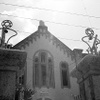Disclaimer
This entry contains information known to us from a variety of sources but may not include all the information currently available. Please be in touch if you notice any inadvertent mistakes in our presentation or have additional knowledge or sources to share. Thank you.
Archive
Magen Avraham (Maghen Abraham) Synagogue at Beirut, Lebanon
Its stucco roof is shattered. The Ten Commandment tablets at the building’s peak have crumbled and graffiti has been spray-painted in the sanctuary. Nonetheless, the Maghen Abraham Synagogue still stands, having survived more than a decade of Civil War street battles and the near-complete disappearance of Lebanon’s Jewish community. Visible from the sea amidst shiny skyscrapers, the abandoned synagogue is a decaying monument to Beirut’s once-thriving Jewish Quarter, which it once anchored. One of over a dozen synagogues that existed in Beirut—and one of several abandoned synagogues that remain scattered across Lebanon—Maghen Abraham may yet be restored if funds can be raised. In the meantime, its shell evokes both a destroyed past and a ruinous future waiting to be fulfilled.
Description
Construction: Lebanon’s Jewish community traces its roots back over three millennia to Biblical times when it was primarily based in the southern city of Sidon. When Beirut began to boom in the early 20th Century, the Jewish community swelled as well with up to more than 14,000 people by the 1940s. The Jewish neighborhood, known as Wadi Abu Jamil, flourished below the Grand Serail (seat of colonial France and currently headquarters of Lebanon’s prime minister) along the bay. A group of small synagogues, mostly within apartments, dotted the neighborhood. But community leaders realized the need for a grand synagogue to anchor a modern community center. Maghen Abraham was inaugurated in 1926, named in memory of the father (Abraham) of a major benefactor, Moise Sassoon of Calcutta (whose family had roots in Baghdad).
Architecture: For a community that previously prayed only in small rooms, Maghen Abraham offered a soaring European-styled building that rivaled other new grand synagogues in Alexandria, Egypt, and Oran, Algeria.1 Despite the overall European structural form, the interior turquoise walls are distinctly Mediterranean, reflecting both the building’s hybrid identity and the diverse cultural forces shaping Lebanese Jews.2 That community’s ultimate identity sits at the pinnacle of the building’s triangular exterior—a depiction of the Ten Commandment tablets.
Community Center: Maghen Abraham anchored a compound of community institutions, including offices of the Hevra Kadisha burial organization, the rabbinate, a social hall, a health clinic, a mikveh, and a small fountain where the Jewish community performed tashlich on Rosh Hashanah. Noted banker Jacob Safra funded a study hall, named “Midrash Eliyahu” in memory of his father. The lot behind the synagogue was filled by the “Selim Tarrab” Talmud Torah day school, which also hosted the Maccabi youth sports club every Sunday afternoon, until the Lebanese government shut it down in 1952. The school courtyard also hosted La Gout du Lait (“Taste of Milk”), a soup kitchen run by local women providing meals to students mostly from poor families. The synagogue itself also hosted a popular youth choir, lectures, wedding celebrations, and twice-annual gatherings of Lebanon’s religious leaders to mark the holidays of Passover and Sukkot. During the 1940s, many illegal migrants from Syria en route to Israel stayed in the synagogue.
Decay: After Lebanon’s Civil War broke out in 1975, congregants found it hard to gather enough people for a minyan at the synagogue. While Jews did not take sides in the war, Muslim militias controlled Wadi Abu Jamil and ongoing skirmishes prompted many Jews to emigrate. In 1976, community leader Joseph Farhi removed the synagogue’s Torah scrolls to the Safra Bank in Geneva. Then in 1978, Chief Rabbi Yacoub Chreim fled Lebanon. Maghen Abraham was later looted, turned into a medical station for Amal militiamen, and even shelled by Israeli ships targeting nearby PLO fighters.3 In 1983, displaced Lebanese Jews in Montreal opened a new Maghen Abraham synagogue there.4 After the Civil War ended, Rafik Hariri’s construction company Solidere began a massive urban renewal project, tearing down most of the buildings in Wadi Abu Jamil—including the Talmud Torah School in 2008.5
Future: The Maghen Abraham sanctuary shell remains largely because Rafik Harari had promised Jewish community representatives that the building would be spared and restored to its former glory. In fact, even Hezbollah representatives have endorsed the restoration. Yet no work has been done because no one has agreed to fund the estimated $1 million project. Isaac Arazi, leader of the tiny Jewish community remnant, has announced restoration plans but also admitted that promised funding from expatriate Lebanese Jews dried up with the 2008 economic downturn.6 As one Lebanese observes, “To leave it dilapidated is to keep the wound open”.7 Without confronting the issue of the Maghen Abraham synagogue head-on, Beirut is falling short of its duty.
Sources
[1] Al Mashriq—The Levant. “The Synagogue of Wadi Bujmil in Beirut [1].” Accessed January 15, 2014. http://almashriq.hiof.no/lebanon/700/720/726/synagogues/beirut/wadibujmil/index.html
[2] Blogging Beirut. “Magen Abraham’s last days – Solidere destroying Beirut’s heritage.” Accessed January 15, 2014, http://www.bloggingbeirut.com/archives/1312-Magen-Abrahams-Last-Days-Solidere-Destroying-Beiruts-Heritage.html
[3] Lost Tribe of Lebanon. “Community Of Magen Abraham.” Accessed January 15, 2014, http://lost-tribe-of-lebanon.blogspot.com/2008/09/magen-abraham-community.html
[4] Maghen Abraham. Accessed January 15, 2014. http://www.maghenabraham.com/
[5] "Magen Abraham's last days - Solidere destroying Beirut's heritage."
[6] Facebook. “Beirut Maghen Abraham Synagogue.” Accessed January 15, 2014. https://www.facebook.com/BeirutSynagogue
[7] Ibid.























